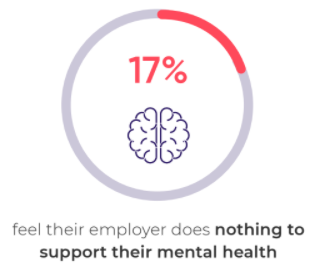Burnout is real
Mental health and burnout are finally coming to the forefront in business.
Back in 2019, two-thirds of workers reported burnout. The Covid pandemic has only exacerbated employee stress levels, with burnout now at a record high of 70% and nearly half of U.S. workers suffering from mental health issues. While employers claim to be stepping up to the plate with mental health offerings, a recent Firstup study finds that employees do not feel supported.
Firstup commissioned research of 23,105 global respondents from the UK, United States, Germany, Nordic countries and Benelux. The respondents were 50% desk-based and 50% deskless from a wide mix of professions.
The study found that despite recent efforts from employers to put in place programs and policies that address burnout and mental health, employees are not feeling the love. The findings included:

- 19% said that their employer has only started showing interest in supporting their mental health since the pandemic.
- 17% (almost 4,000 respondents) said their employee does not support their mental health and it makes them feel worthless.
- 22% said their employer has the intention to support their mental health but they don’t feel supported.
- 27% said more can be done by the company to respect my ‘out of hours’ time
So what can companies do to further support employees?
Recently, Brittany Barhite, Communications Director, and Rupert Coghlan, Principal Solutions Consultant, at Firstup came together at the Engage Digital Workplace Conference to consider what companies can do to further support employees…and it’s not more yoga!
During their discussion, they shared the latest research findings on how employees actually feel and laid out practical steps that can be taken to develop wellness and mental health programs.
Time for an overhaul
Here are five ideas to consider when overhauling your wellness and mental health programs.
- Offer flexibility: In the study, 29% of respondents wanted more flexible working hours within the working week. Flexible working hours allow employees to juggle the demands of kids, a two-income household and the now endless workday and can actually cut down on chronic absenteeism. With employees attending global meetings during early mornings and late nights, flexible hours allow them to have an actual 8-hour workday.
“When your kitchen table becomes your office, it gets harder and harder to distinguish between work and home.”
—CNBC | The year is over and workers left almost all of their vacation days on the table
- Provide true days off: This study showed that thousands of employees felt companies did not have boundaries in place to respect their work-life balance. 20% of respondents want it to be required that internal emails are not sent after working hours and 25% of respondents want designated mental health days.
To tackle burnout, some companies, including LinkedIn, Bumble, and Hootsuite, have found it beneficial to shut down as a company for a week. This forced shutdown shows that 1) managers at the top truly value taking a break and 2) it allows employees to truly disconnect since emails and work are not continuing while they are out.
In 2020, Firstup announced “Distancing Days” and has continued this benefit monthly. Much to the delight of the employees, Firstup shuts down one day a month to allow all teams to disconnect and rest. This allows employees to truly take a break and come back recharged for their customers.
Another trend is providing vacation bonuses when employees disconnect. Firstup offers what we call a ‘Fruity Drink Bonus’ whereby if an employee takes five days off in a row and gets that true disconnect, they get a bonus!! HR can also work with IT to discuss turning off technology or notifications during non-work hours or vacation days.
- Do more with benefits: The pandemic has handed employees new challenges, especially with childcare. Some companies took notice in 2020 and added child-care benefits such as backup child care and stipends for college counseling services and tutoring. Employees are also taking care of their aging parents. Understanding the needs of your employees and sweetening your benefits packages can go a long way in helping ease the everyday stresses employees are facing.
“One of the biggest barriers for working parents is lack of access to affordable child care.”
—McKinsey | Ten insights on the state of economic opportunity
- Prioritize work: 28% of respondents want senior management to have an in-depth understanding of what they’re doing each day AND intervene if they are overloaded with tasks. These same respondents want their managers to do a better job assigning a workload that can be accomplished in a 40-day week. To help with prioritization, managers should meet with their employees regularly to discuss projects and prioritize them together. These conversations can be crucial because managers can better understand what their employees are working on and employees can seek clarification on tasks. Oftentimes, these conversations reveal tasks that employees assumed were essential, but managers consider ‘nice to haves’ and not business-critical. For tips on communicating with employees and finding out what they need, check out the 3 ways to introduce meaningful employee listening!
“Usage is abysmal,” says Christopher Calvert, senior vice president for health at New York City-based Sibson Consulting. “Most companies aren’t communicating their EAPs well. It wouldn’t occur to employees to call.”
—SHRM | Companies Seek to Boost Low Usage of Employee Assistance Programs
- Communicate, communicate, communicate: Communication is foundational to employee wellness. Employee assistance programs suffer from an awareness problem. Even if a company offers an EAP program, many employees don’t know it exists. Companies should continue communicating their wellness programs and benefits through various channels to ensure employees are aware of the offerings.
Managers also need to open lines of communication that provide a safe place for employees to discuss their mental health and burnout concerns. Having candid conversations about mental health decreases the stigma and helps employees feel comfortable asking for help or time off.
Finally, managers should ‘walk the talk’ and showcase it broadly through communication channels. Cultural change starts at the top and managers need to encourage employees to feel comfortable seeking help and balancing the demands of their personal and professional lives. When employees see their managers putting wellness first, they are more likely to do the same. For more information, take a peek at the 9 elements of a complete employee experience.
“Line managers have an outsized impact on employees’ experience, workload and flexibility. Many employers introduced centrally led efforts that sounded great on paper but fell flat because managers held their teams to pre-pandemic standards or felt pressure themselves to perform no matter what.”
—Tamara Rodman, Senior Partner, Korn Ferry
Putting it into practice
For Firstup customer Hawai’i Pacific Health, addressing burnout in the healthcare industry meant putting as much focus on wellness as they did on other communication. They found that it came down to listening, empathy, striving to understand, and then taking real action on what employees needed.
“There was just such a desperate need for information because the anxiety level was so high, that we needed a way to get messages out to people very, very quickly because there were just so many unanswered questions.”
– Raquel Hicks, Director of Organizational Effectiveness
They needed a way for leaders to speak directly to staff in authentic and transparent ways, and they also needed to provide their staff with an easier way to access wellness resources to counter the rising anxiety and burnout.
In response, the team launched a number of wellbeing initiatives, offering mindfulness and meditation opportunities and a wellbeing podcast, in which two HPH employees share stories and conversations from frontline workers across the community.
Conclusion
These past few years have forced every organization to see their workers for more than just the job they perform and recognize what other challenges they might be facing at home. By talking openly about mental health and its impact, employers can begin to normalize conversations and help make a real impact on employee wellness.
Watch the full conversation with Brittany Barhite and Rupert Coghlan on what companies can do to deliver a workplace wellness program and further support employees:
Download PDF









